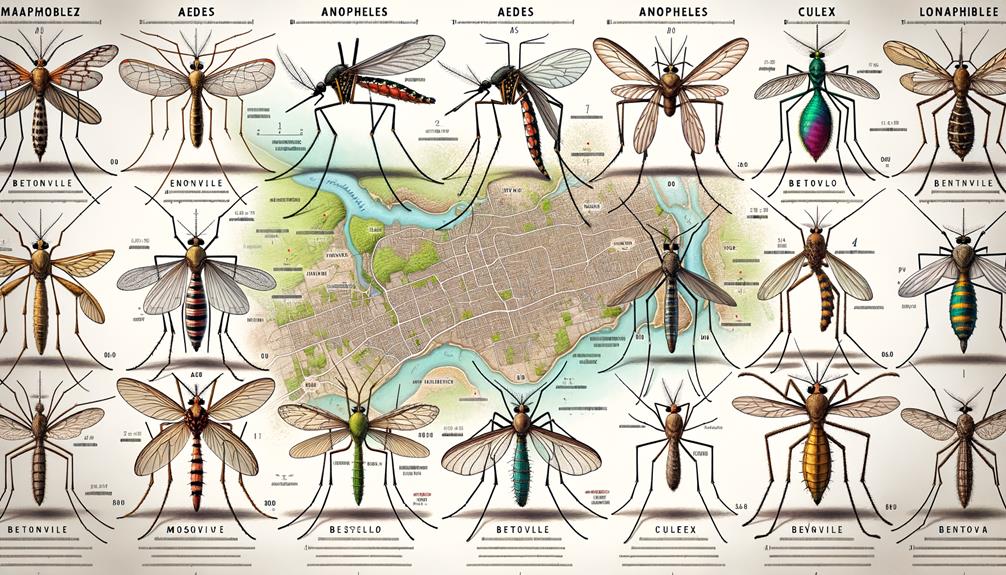To identify different mosquito species in Bentonville, observe Aedes, known for small size and white stripes. Culex, active at dawn and dusk, prefer stagnant water. Anopheles, with long palps and shaggy abdomen, feed at night. Look for larvae habitats, consider seasonal abundance, and inspect unique markings. Learn why species identification matters for targeted control and disease prevention. Understanding behaviors and physical traits is key.
Key Takeaways
- Use identification guides for species recognition based on physical traits.
- Look for unique markings like stripes, spots, and wing patterns.
- Pay attention to resting positions and feeding habits for species differentiation.
- Consider larval habitats, breeding sites, and seasonal abundance.
- Evaluate blood feeding patterns and host preferences for species identification.
Physical Characteristics of Aedes Mosquitoes
Characterized by their small stature and distinctive white stripes on their legs and body, Aedes mosquitoes exhibit a unique posture with their bodies angled upwards when at rest. When identifying Aedes mosquitoes, make sure to look for these key physical traits as they can help distinguish them from other mosquito species. The dark coloration of their bodies contrasted with the striking white bands makes them easily recognizable. Additionally, their habit of holding their bodies at an angle is a critical characteristic not commonly seen in other mosquitoes.
Aedes mosquitoes are known for their aggressive nature, particularly their daytime biting habits, unlike many other mosquito species that primarily feed during the evening. This behavior is vital to note when implementing control measures to reduce their population. Understanding the physical characteristics and behavior of Aedes mosquitoes is essential in effectively managing and preventing the spread of diseases they carry. By being able to identify these mosquitoes accurately, you can take the necessary precautions to protect yourself and your community from potential health risks.
Behavior of Culex Mosquitoes
When observing Culex mosquitoes, their distinctive feeding behavior at dawn and dusk sets them apart from other species. Here are some key habits of Culex mosquitoes:
- Feeding Preferences:
Culex mosquitoes are primarily active during dawn and dusk, preferring to feed at these times. They're attracted to carbon dioxide and body heat, making humans a target for their blood meals.
- Resting Positions:
These mosquitoes have a unique resting position where their bodies are angled upward, and their heads point downward. This distinct posture distinguishes them from other mosquito species.
- Disease Carriers:
Culex mosquitoes are known carriers of diseases such as West Nile virus and encephalitis, making them a potential health threat in areas where they're prevalent.
- Breeding Sites:
Culex mosquitoes breed in stagnant water sources like ponds, ditches, and bird baths. Eliminating these breeding grounds can help reduce their population and minimize the risk of disease transmission.
Identifying Anopheles Mosquitoes by Appearance
Anopheles mosquitoes stand out due to their distinctive palps, which are as long as their proboscis. These palps are easily noticeable and aid in their identification.
Additionally, Anopheles mosquitoes have unique wing patterns characterized by spots and a mix of dark and light scales. Observing the wings can help differentiate them from other mosquito species in Bentonville.
Another key feature is their resting position. Anopheles mosquitoes rest with their bodies at an angle to the surface, unlike many other mosquitoes that rest parallel to the surface. This distinct behavior can be an important factor in identifying them.
Moreover, the abdomen of Anopheles mosquitoes has a shaggy appearance, which is different from other species. Remember, Anopheles mosquitoes are also known for their preference to feed during the night, setting them apart from other mosquito species in the area.
Differentiating Mosquito Species in Bentonville
To differentiate mosquito species in Bentonville, closely examine the unique markings and physical characteristics present on their bodies. When identifying different mosquito species in Bentonville, consider the following:
- Larval Habitats and Species Diversity: Investigate where the larvae are found, as different species may prefer distinct aquatic environments for development.
- Seasonal Abundance and Breeding Sites: Note the times of the year when certain species are more prevalent and the specific breeding grounds they favor.
- Blood Feeding Patterns and Host Preferences: Study the feeding behavior of mosquitoes, including which animals they tend to bite, to help distinguish between species.
- Use of Identification Guides: Utilize mosquito identification guides specific to Arkansas or Bentonville to learn about the various species and their distinguishing features.
Importance of Mosquito Species Identification
Identifying mosquito species in Bentonville is essential for developing targeted control strategies and evaluating disease transmission risks accurately. Different species of mosquitoes have varying behaviors and preferences, impacting the effectiveness of control measures. By understanding the specific types of mosquitoes present in an area, public health officials can tailor prevention efforts to mitigate disease transmission risks effectively.
Accurate identification of mosquito species is critical for implementing control strategies that are specific to the behavior and habitats of each species. This knowledge allows for the strategic placement of control measures such as insecticides or breeding site removal, enhancing the overall effectiveness of mosquito population management.
Ultimately, the identification of mosquito species in Bentonville plays a crucial role in safeguarding public health. By monitoring population trends and evaluating the impact of control interventions, authorities can better protect the community from mosquito-borne diseases. This emphasis on species identification is key to ensuring thorough public health protection against the risks associated with mosquito populations.
Frequently Asked Questions
How Do I Identify a Mosquito Species?
To identify a mosquito species, observe body color, size, and leg markings. Note feeding patterns and flight habits. Use guides or online resources. Consider habitat preferences. Consult experts for help. Follow these steps for accurate identification.
What Type of Mosquitoes Are in Arkansas?
In Arkansas, various mosquito species like Aedes and Culex inhabit different regions due to their preferences for habitats and climate. Understanding these mosquito habits and breeding behaviors is essential for effective control measures to combat diseases.
How Can You Tell the Difference Between Mosquitoes?
To tell the difference between mosquitoes, observe distinct wing patterns, proboscis length, and abdomen colors. These features are key identifiers. Pay attention to these details to accurately distinguish between various mosquito species in Bentonville.
How Do You Tell Mosquitoes Apart?
To tell mosquitoes apart, observe their physical traits, behaviors, and habitats. Look for distinct markings on their bodies and wings. Consider their feeding preferences and breeding habits. Different species may vary in disease transmission capabilities.





